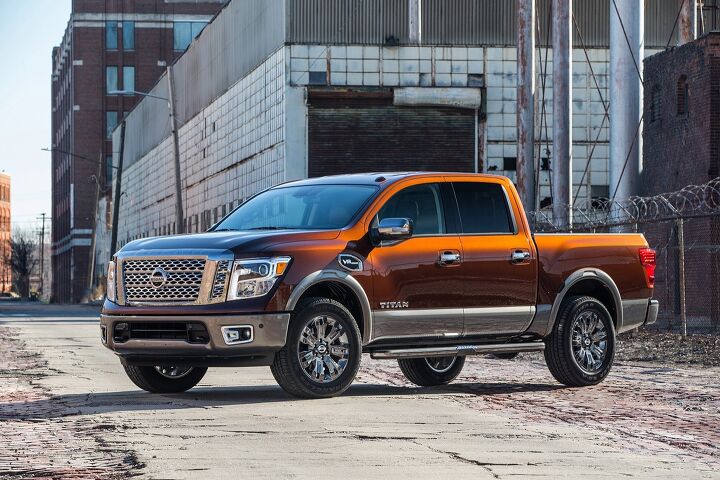Made for America, the Nissan Titan Expands Its Horizons

In terms of monthly U.S. sales, Nissan’s line of Titan pickups ended September in the number nine spot, ahead of the midsize GMC Canyon but behind its own paleolithic Frontier. While the 3,773 Titan and Titan XDs sold last month represent a tiny fraction of the 82,302 Ford F-Series models sold in the same time frame, it’s still a 52-percent increase from the same month in 2016.
Year-to-date, however, Titan sales are up 224 percent in the United States. That’s enough to get Nissan thinking about the pickup’s potential in markets not dominated by tried-and-true nameplates from the Detroit Three.
It seems Nissan’s planning to seize some ground for itself on fertile — but traditionally unfriendly — terrain. Looking back, the looming push was obvious.
According to Automotive News, the Titan will travel overseas as part of Nissan’s attempt to infiltrate new markets. If it pulls it off, Nissan just might make the word “Titan” resonate with some of the same authority as “Silverado” and “F-150.”
Among the possible new markets for the Titan line are China (always a favorite), Russia, Australia, and the Middle East — each a vastly different market where American truckmakers are hesitant to tread. Certainly, the full-size Titan and its almost-but-not-quite heavy duty sibling appear to have been shaped for exactly this role. If Nissan just wanted an also-ran in a hot segment, why bother offering a Single Cab configuration on both models?
Why offer an extended King Cab with a rear-seat delete option? Why make a 5.6-liter V8 standard in the Titan and offer a 5.0-liter Cummins turbodiesel V8 in the XD? It’s obvious Nissan wants customers to put these trucks to work, and it’s making it as enticing as possible.
“We are now looking at other markets where we can introduce the full-size pickup,” said Ashwani Gupta, senior vice president of the Renault-Nissan Alliance’s light-commercial business unit, ahead of the Tokyo Motor Show. “That market is really growing.”
Still, overseas markets are used to smaller trucks. That’s why Nissan seems prepared to pitch the Titan at fleets and construction crews — customers that might soon become addicted to the extra capacity and power. While Gupta didn’t come right out and say this, it’s telling that the model is now grouped under the automaker’s global light-commercial business unit.
Alongside the Titan push, Nissan also plans to woo more customers with its midsize Navara pickup, as well as a Renault variant. (Recall that the Mercedes-Benz X-Class also uses the Navara as a starting point.) Nissan recently introduced the Navara in China. Just to ensure the lower end of the pickup market is completely covered, the slightly smaller Triton — built by newly acquired Alliance partner Mitsubishi — is tapped to serve in the emerging market product deluge.
[Images: Nissan]

More by Steph Willems
Latest Car Reviews
Read moreLatest Product Reviews
Read moreRecent Comments
- Zipper69 Significant that no Korean manufacturers appear in that list.is there a 250-300k line they just can't cross?
- Robert My guess is that it’s driven by cost, liability and responsibility. Cost, at least where I live, is not insignificant. Charge at the wrong time of day and it’s about $0.90 per kWh. Ouch! Meaning that charging would have to be tied back to the owner somehow. Responsibility being maintaining and managing the chargers and dealing with potential problems which they may not want to deal with.Personally, I wouldn’t touch an EV ability to homecharge.Proud owner of Mini Cooper SE, Volvo XC90 Recharge and a gas guzzling 2024 Mustang GT!
- ToolGuy "All this means that you, the car buyer, have likely at some point in your life bought a new or thoroughly redesigned model during its first model year and experienced problems." 👉️ No, actually, never, because I don't do that.
- ToolGuy Thankfully some of us have the TTAC Podcast to guide us.
- Pete Skimmel That all makes sense to me, find a way to pay for value received. Everyone wins.




































Comments
Join the conversation
Predicting success or otherwise for the Titan in Australia is simple. If it is engineered to be built in RHD without extra cost and it is bigger than a Ford Ranger then it is a slam dunk. We would all drive American trucks if they didn't cost $20,000 or more for local RHD modification.
I don't think this is the worst idea. There are parts of the world where a Nissan full-sized truck would be at less of a disadvantage with respect to brand loyalty and how buyers use trucks. Unfortunately for them those are much less profitable sales as well but may as well get something from that capacity. I finally got to drive a new F250 and I'd choose it over the Titan I think but Im still firmly in half ton territory though a potential RV upgrade may move me beyond the 2.7s comfort zone.